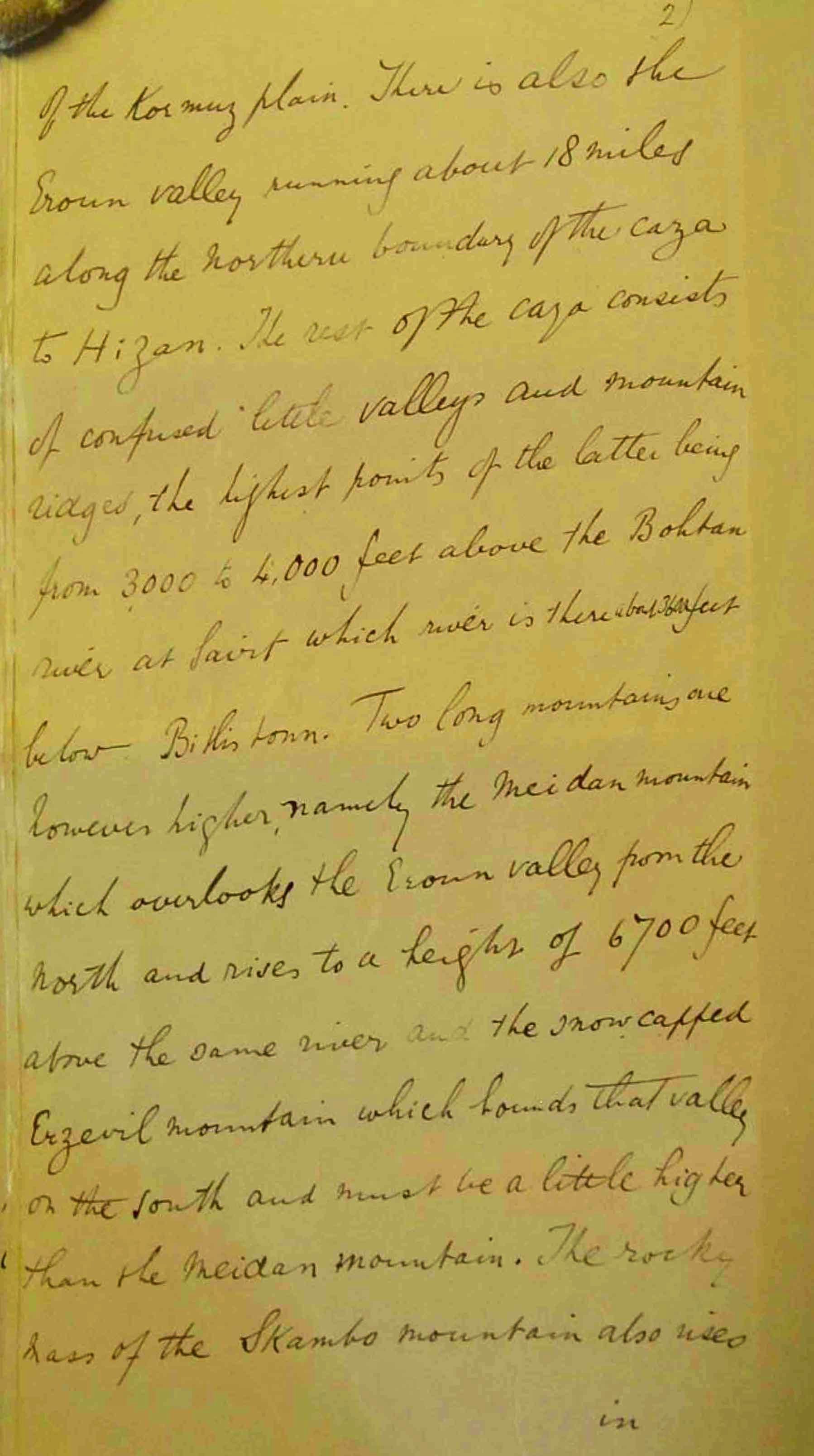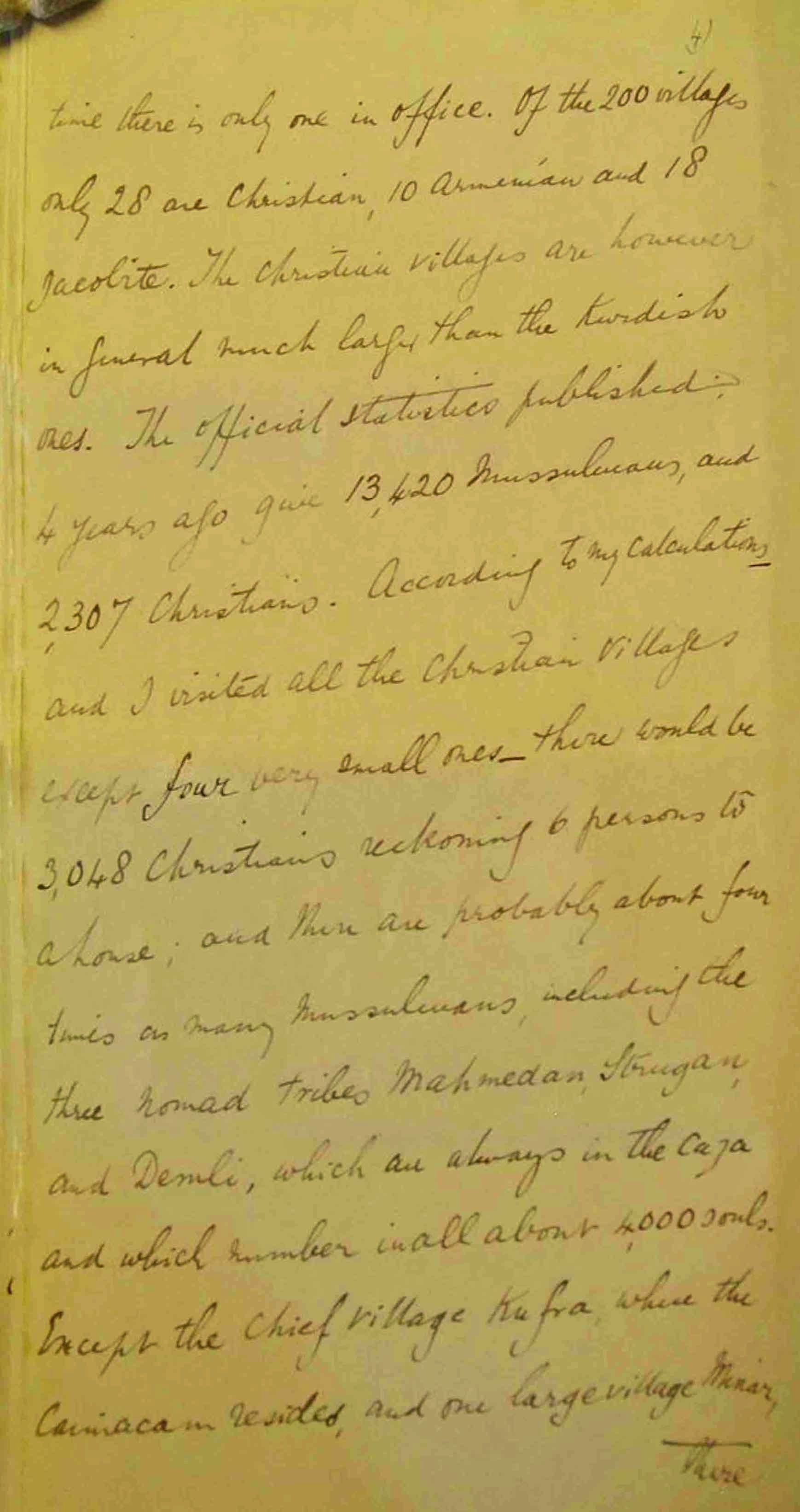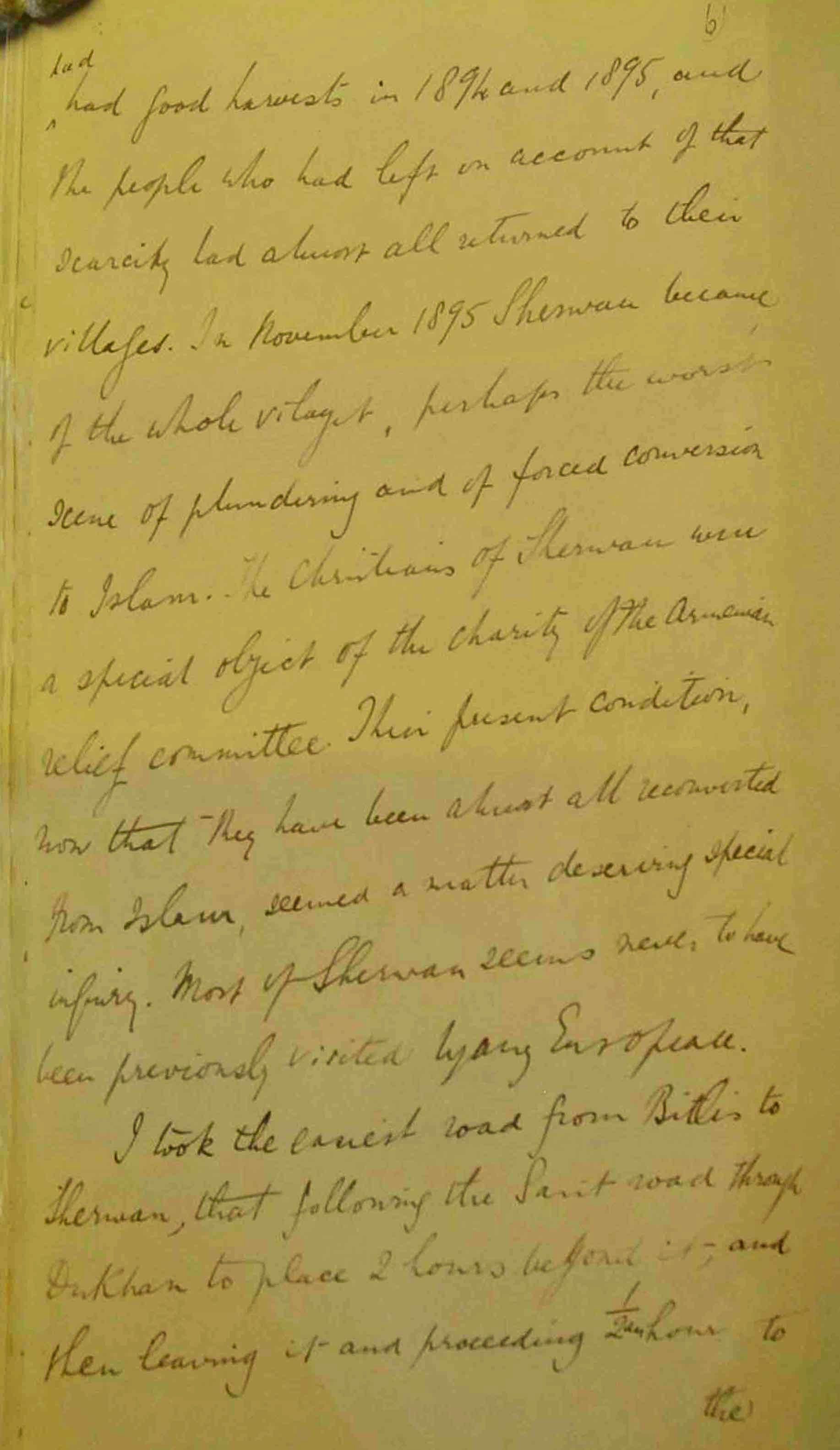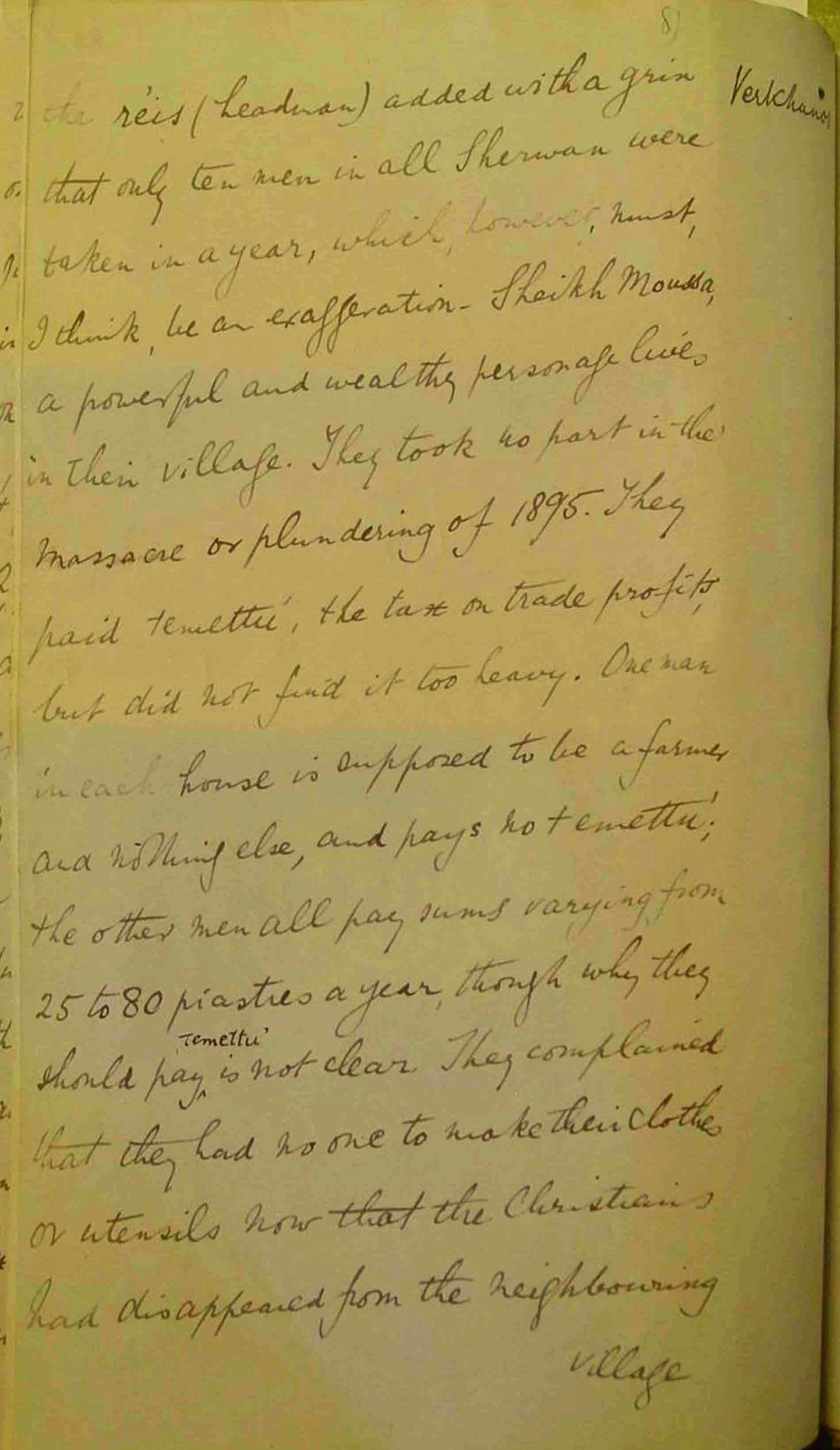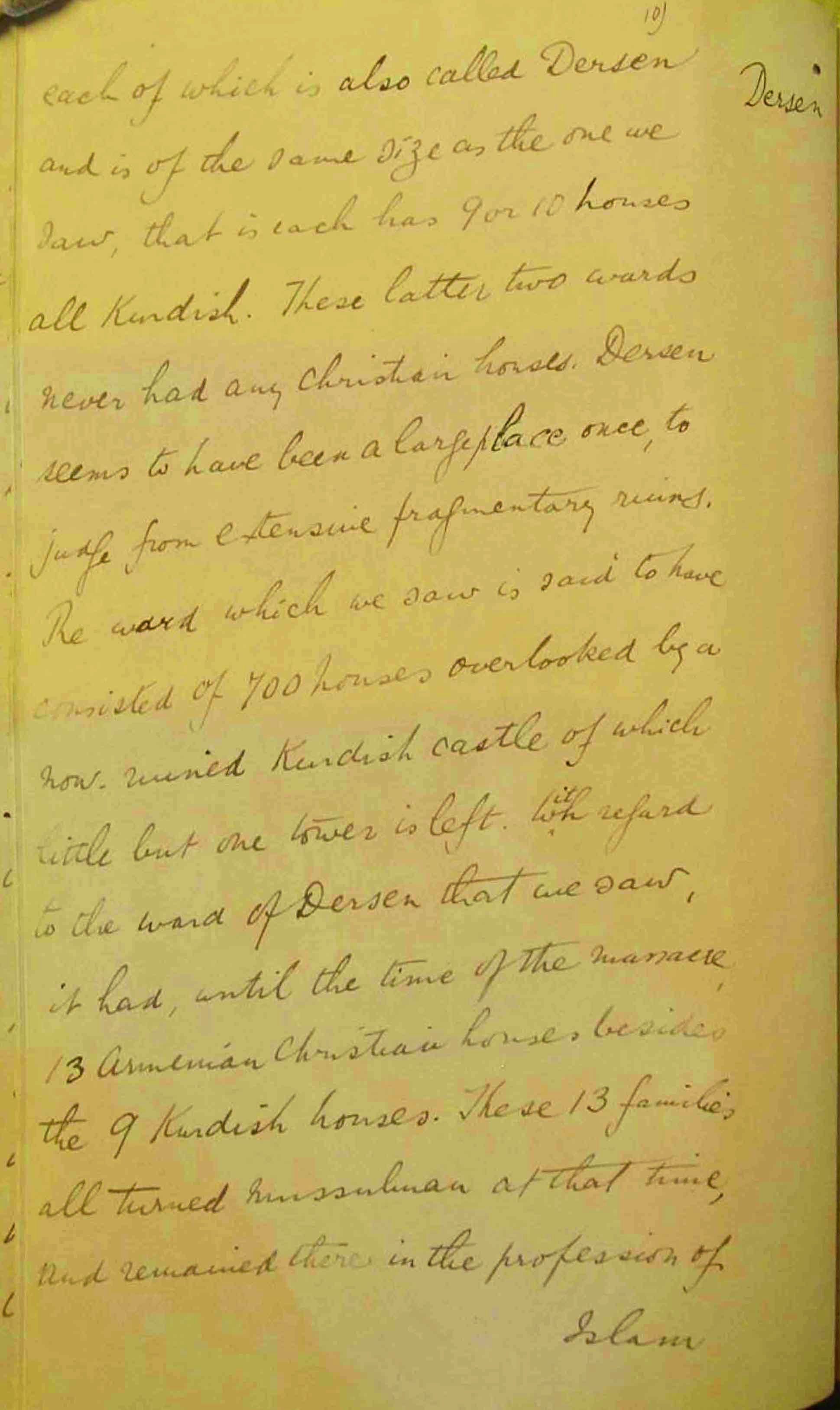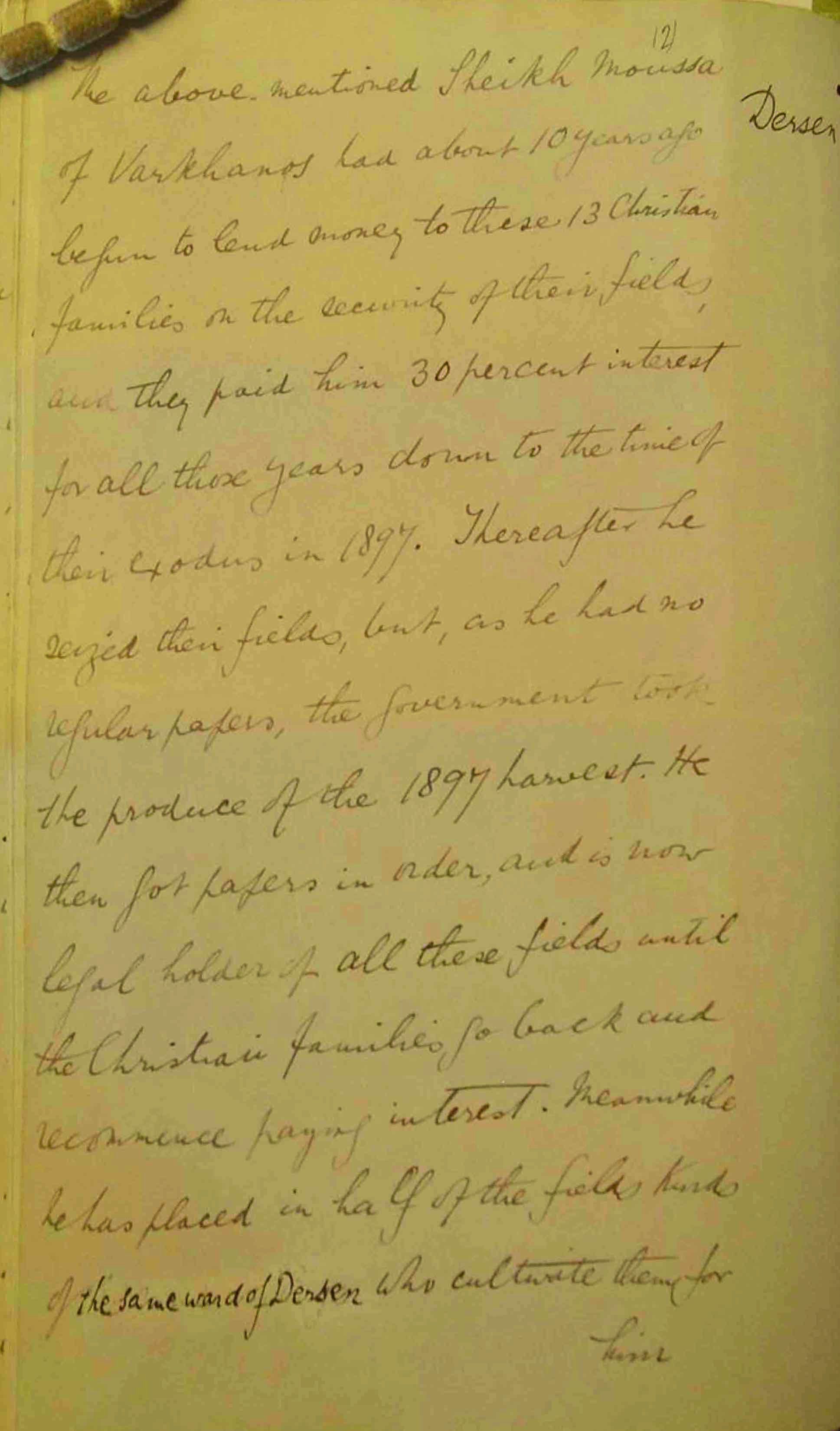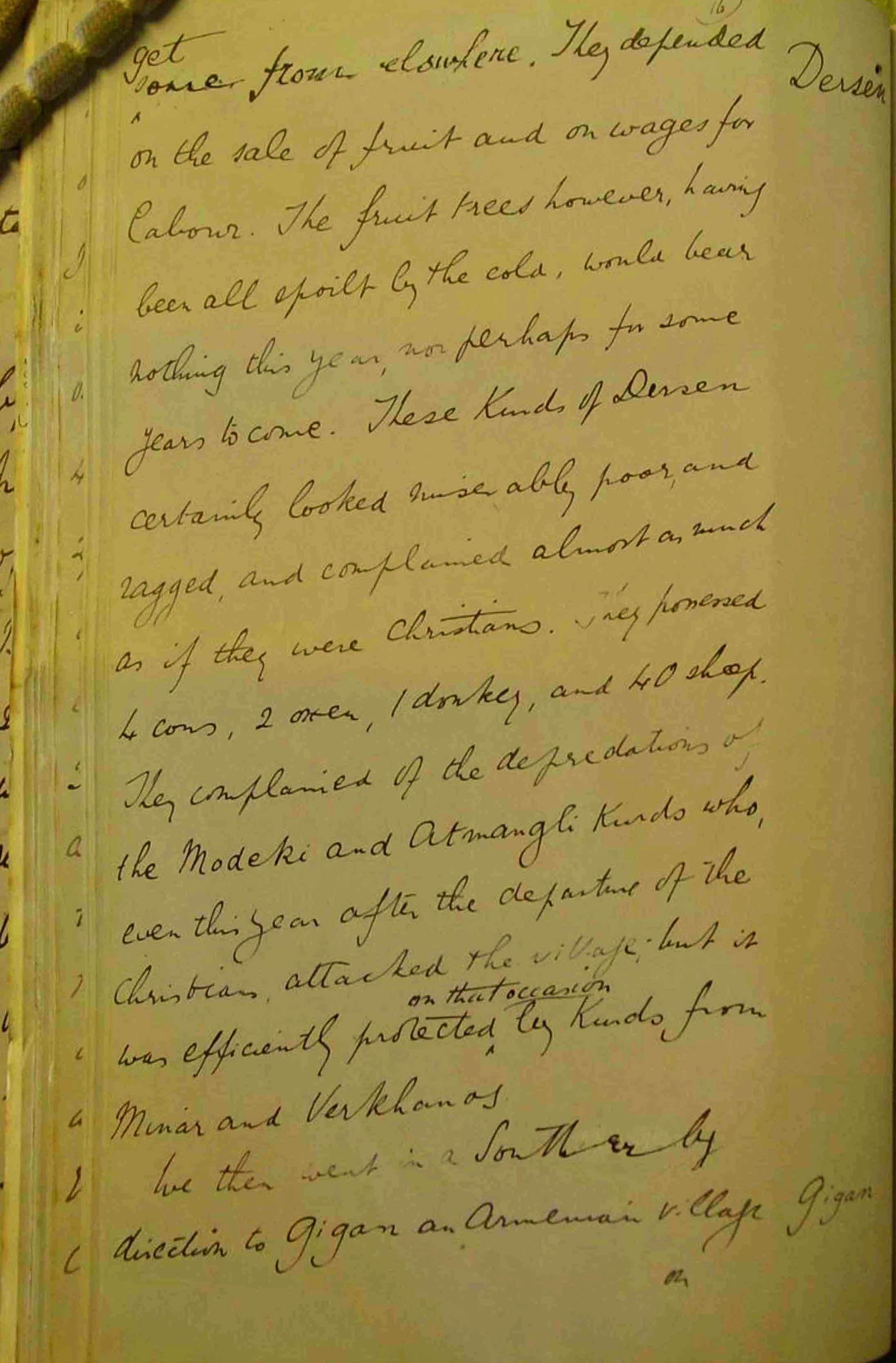19th century sources
website of Jelle Verheij, historian
home | publications | my photos | historical pictures | travel snap shots | monuments | 19th century sources | research tools | links | contact
Report on a Journey in the Cazas Sherwan, Sairt, and Aroh May and June 1898
(by J.H. Monahan, British Vice-Consul in Bitlis)
(157)
Sherwan Caza
Sherwan is a mountainous caza of the Sairt Sanjak, bounded on the north by the Bitlis central caza, its northern boundary being about 8 hours from Bitlis, on the South by the Bohtan river, on the East by Hizan, and on the West by the Garzan Caza. It has two fairly open plans between the mountains, namely, the Kormuz plain about 5 miles wide and stretching about 10 miles in length to the hills which overlook the right bank of the Bohtan, and the still smaller Kosakh plain, or wide valley, at the South Eastern corner
[158] in the Northwestern corner of the caza to about the same heighth as the Erzevil mountain, I would say however that my geographical statements are merely the roughest approximations and the map … herewith has no pretension whatever to scientific accuracy.
Sherwan is famous for its vines, though little wine or raki was ever made of it, and now less than ever. Pomegrate and fig trees abound in the southern half of the caza, and walnut and pear trees all over it. Most of the valleys south of the Eroun valley are free from snow all the year around. There is some rice cultivation in the southern valleys.
The caza is said to have 200 villages, most of them consisting however of 6 houses or less. It is supposed to have six nahiés, but only three mudirs are ever[?] in office, at at the present time
(157v)
of the Kormuz plain. There is also the Eroun valley, running about 18 miles along the northern boundary of the Caza to Hizan. The rest of the caza consists of confused little valleys and mountain ridges, the highest point of the latter being from 3,000 to 4,000 feet above the Bohtan river at Sairt, which river is there about 3,000 feet below Bitlis town. Two long mountains are however higher, namely the Meidan mountain which overlooks the Eroun valley from the north and rises to a height of 6700 feet above the same river and the snowcapped Erzevil mountain which bounds that valley on the south and must be a little higher than the Erzevil mountain. The rocky mass of the Skambo mountain also rises
[158v] there is only one in office. Of the 200 villages only 28 are Christian, 10 Armenian and 18 Jacobite. The Christian villages are however in general much larger than the Kurdish ones. The official statistics published 4 years ago give 13,420 Mussulmans, and 2,307 Christians. According to my calculation, and I visited all the Christian villages except four very small ones, there would be 3,048 Christians reckoning 6 persons to a home; and there are probably about four times as many Mussulmans, including the three nomad tribes Mahmedan, Strugan and Demli, which are always in the caza and which number in all about 4,000 souls. Except the chief village Kufra, where the Caimacam resides, and one large village Minar
[159] there are no mixed villages, that is to say villages now inhabited by both Christians and Mussulmans. There is no Christian school in the whole of Sherwan, nor, so far as I can learn, has there ever been one, and of Mussulan schools none but a few very small Koran schools; and the people in general have remained more ignorant and backward than those of any part of the Vilayet outside the Sairt Sanjak. There are however some remnants of a former civilization, which is said to have been Persian. Kurdish Beys until about 50 years ago ruled in their now ruined castle, but their descendants have now sunk almost to the common squalor.
The people, Kurdish and Christian, were living together in tolerable peace and comfort until November 1895. They had almost entirely recovered from the effects of the scarcity of 1892. They
[159v] had good harvests in 1894 and 1894, and the people who had left on account of that scarcity had almost all returned to their villages. In November 1895 Sherwan became of the whole vilayet, perhaps the worst scene of plundering and of forced conversion to Islam. The Christians of Sherwan were a special object of the charity of the Armenian Relief Committee. Their present condition, now that they have been almost all reconverted from Islam, seemed a matter deserving special inquiry. Most of Sherwan seems never to have been previously visited by any European.
I took the easiest road from Bitlis to Sherwan, that following the Sairt road through Dukhan to place 2 hours beyond it - and then leaving it and proceeding 1/2 hour to
[160] the South west to Verkhanos the first village that I visited in the Sherwan caza. Verkhanos is a Kurdish village of 60 houses, a large village for Sherwan. It is perched on the mountain, and? overlooking the valley of Dersen, to the Southwest, about 1,500 feet below it. The villagers seemed, and said they were happy and prosperous; only that their walnut, fig, and pomegranate had alle been blighted by the severe weather last autumn, as was the case with the walnut and trees generally all over Sherwan. Their tithes, they said, were bought by themselves last year for 40 Liras, and were very light for them. They said that very few of them were ever taken for military service,
[160v] the reis (headman) addd with a grin that only ten men in all Sherwan were taken in a year, which, however, must, I think, be an exaggeration. Sheikh Moussa, a powerful and wealthy personage, lives in their village. They took no part in the massacre and plundering of 1895. They paid temettié, the tax on trade profits, but did not find it too heavy. One man in each house is supposed to be a farmer and nothing else, and pays no temettié, the other men all pay sums varying from 25 to 80 piastres a year, though why they should pay temettié is not clear. They complained that they had one to make their clothes and utensils now that the Christians had disappeared from the neighbouring
[161] village Dersen. They seemed remarkably well clothed, though their houses and mode of life are the same of those of the Christians. The houses of Shirwan are, like the Bitlis houses, constructed of rough stones with roofs of mud and timber, and nearly all of two stories with a stable on the ground floor, so may said to be of a higher order of architecture than the dwellings or burrows of the northern part of the vilayet.
From Verkhanos I proceeded 2 hours in a southwesterly direction down the mountain and along a valley to the low lying village Dersen. This Dersen consists of 9 Kurdish houses, but there are two others wards or quarters out of sight
[161v] each of which is also called Dersen and is of the same size as the one we saw, that is each has 9 or 10 houses, all Kurdish. These latter two wards never had any Christian houses. Dersen seems to have been a large place once, to judge from extensive fragmentary ruins. The ward we saw is said to have consisted of 700 houses overlooked by a now ruined Kurdish castle of which little but one tower is left. With regard to the ward of Dersen we saw, it had, until the time of the massacre, 13 Armenian Christian houses, besides the 9 Kurdish houses. These 13 families all turned Mussulman at that time, and remained there in the profession of
[162] Islam until May 1897 when they were all moved to Bitlis and became Christians again. The were in receipt of relief for 2 or 3 months of the Summer of 1897, but have since succeeded in finding a livelihood from work in the town. In Dersen again the Kurds expressed the wish that these Christian families should return, and assured that they be free to practise their religion. They are badly wanted to spin cotton for them and to make their ‘shalwars’ (wide cotton wooden trousers). The Kurds, with the exception of some of their women, are as a rule incapable of making anything.
[162v]
The above mentioned Sheikh Moussa of Varkhanos [sic] had about 10 years ago begun to lend money to these 13 Christian families on the security of their fields and they paid him 30 percent interest for all those years down to the time of their exodus in 1897. Thereafter he seized their fields, but, as he had no regular papers, the Government took the produce of the 1897 harvest. He then got papers in order, and is now legal holder of all these fields until the Christian families go back and recommence paying interest. Meanwhile he has placed in half of the fields Kurds of the same ward of Dersen, who cultivate them for
[163] him on the metayer system. He has also by moneylending got some of the Kurds of Dersen in his power. The tithes of the three wards of Dersen taken together were, in the autumn of 1897, sold for 31 Liras to the village itself. The headman complained that this sum was excessive, and said it was the same for which the tithes had been sold 6 years ago when wheat was at the famine price of 3 piasters an oke, it being now at less than 1 piaster the oke. I understand that no village which has not a strong protector or is not for some reason favoured by Government will ever buy its own tithes unless forced to do so by the fact that no one else will, as the Government will with very rare exceptions always refuse to take the collection of tithes on its own hands, and the corps meanwhile are ruined by the
[163v] delay. I was however rather surprised by the complaints of the Kurdish headman, and I endeavoured to get some knowledge of the facts of the case. My dragoman Agop Effendi, who is an experienced agriculturist, inspected the fields of the 9 Kurdish families, and estimated that they would produce in one year 1,200 okes of wheat to the value of 1,000 piasters and 800 okes of millet of the value of 6 piasters, giving a total value of grain produce of 1,600 piasters or 16 liras. We may then suppose that the produce of the fields of the dispossessed Christian families would be worth about 21 liras, giving a total value of 37 liras for the grain produce of this ward of Dersen. Supposing that the fruit was worth as much as the grain, as the headman assured
[164] us it was, we get a total value of of 74 liras for the produce of this ward. Assuming that the other two small wards had proportionately valuable produce, the total for those two wards would be 64 liras, giving a grand total for the three wards of 138 liras on which 31 liras for tithes would evidently be excessive.
The 9 families have, as we have seen, 2,000 okes of grain from their own fields, and will have this year besides, on the metayer arrangement with Sheikh Moussa, about 700 okes of grain from the fields of the 13 dispossessed Christian families, so that, even this year, there will be only 2,700 okes of grain among 54 persons counting the family at 6 persons. As they live chiefly on grain they clearly must
[164v] get some from elsewhere. They defended on the sale of fruit and on wages for labour. The fruit trees however, having been all spoilt by the cold, would bear this nothing this year, nor perhaps for some years to come. These Kurds of Dersen certainly looked miserably poor and ragged, and complained almost as much as if they were Christians. They possessed 4 cows, 2 oxen, 1 donkey, and 40 sheep. They complained of the depredations of the Modeki and Atmangli Kurds who, even this year after the departure of the Christians, attached the village; but it was efficiently protected on the occasion by Kurds from Minar and Verkhanos.
We then went in a Southern directory to Gigan, an Armenian village
[165] on a slope overlooking the plain of Garzan. It had before the massacres 30 houses, all Armenian, bus has now only 20. All the fields, without exception, are now held in “miribalik”. This word means that a man pays half the produce of his land every year as interest on money lent, and, if he fails to pay, forfeits the whole of the land. They are this mortgaged mostly to Kurds of Verkhanos especially the above-mentioned Sheikh Moussa. Last year the fields produced only 2,400 okes of grain of a money value of 2,400 piasters (gold). The yield of the vineyards was 1,400 piasters, that of the fruit trees 600 piasters. The fruit trees are for the present destroyed and cannot recover for 2 or 3 years to come. The village bought its own tithes last year for
Sherwan → Şirvan (district in Siirt province)
pages 157 - 165
